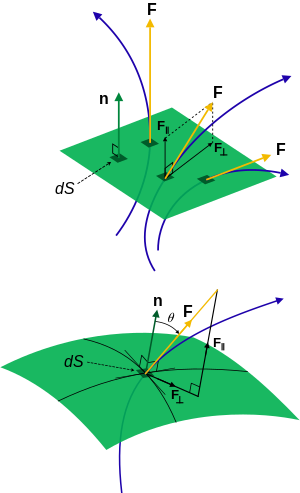This article summarizes equations in the theory of fluid mechanics.
DefinitionsEdit
Flux F through a surface, dS is the differential vector area element, n is the unit normal to the surface. Left: No flux passes in the surface, the maximum amount flows normal to the surface. Right: The reduction in flux passing through a surface can be visualized by reduction in F or dS equivalently (resolved into components, θ is angle to normal n). F•dS is the component of flux passing through the surface, multiplied by the area of the surface (see dot product). For this reason flux represents physically a flow per unit area.
Here  is a unit vector in the direction of the flow/current/flux.
is a unit vector in the direction of the flow/current/flux.
| Quantity (common name/s) | (Common) symbol/s | Defining equation | SI units | Dimension |
|---|
| Flow velocity vector field | u |  | m s−1 | [L][T]−1 |
| Velocity pseudovector field | ω |  | s−1 | [T]−1 |
| Volume velocity, volume flux | φV (no standard symbol) |  | m3 s−1 | [L]3 [T]−1 |
| Mass current per unit volume | s (no standard symbol) |  | kg m−3 s−1 | [M] [L]−3 [T]−1 |
| Mass current, mass flow rate | Im |  | kg s−1 | [M][T]−1 |
| Mass current density | jm |  | kg m−2 s−1 | [M][L]−2[T]−1 |
| Momentum current | Ip |  | kg m s−2 | [M][L][T]−2 |
| Momentum current density | jp |  | kg m s−2 | [M][L][T]−2 |
EquationsEdit

is a unit vector in the direction of the flow/current/flux.